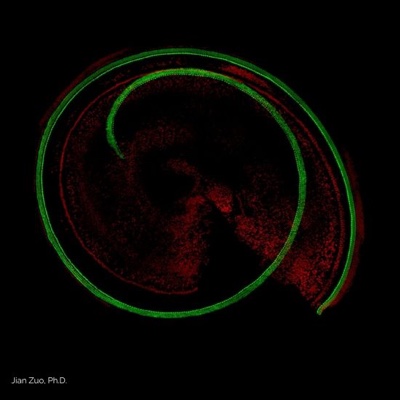St. Jude Children's Research Hospital scientists have regenerated immature auditory hair cells in adult mice by manipulating two genes. The research offers clues for better treatment of hearing loss.
Memphis, Tennessee, April 11, 2017 - In an apparent first, St. Jude Children’s Research Hospital investigators have used genetic manipulation to regenerate auditory hair cells in adult mice. The research marks a possible advance in treatment of a leading cause of hearing loss in adults. The study appears today in the journal Cell Reports.
Loss of auditory hair cells due to prolonged exposure to loud noise, accidents, illness, aging or medication is a cause of long-term disability in adults worldwide. Certain chemotherapy agents can also damage hair cells, leaving some childhood cancer survivors at risk for hearing loss. Treatment has focused on electronic devices like hearing aids or cochlear implants because once lost, human auditory hair cells do not grow back.
“In this study, we looked to Mother Nature for answers and we were rewarded,” said corresponding author Jian Zuo, Ph.D., a member of the St. Jude Department of Developmental Neurobiology. “Unlike in humans, auditory hair cells do regenerate in fish and chicken. The process involves down-regulating expression of the protein p27 and up-regulating the expression of the protein Atoh1. So we tried the same approach in specially bred mice.”
By manipulating the same genes, Zuo and his colleagues induced supporting cells located in the inner ear of adult mice to take on the appearance of immature hair cells and to begin producing some of the signature proteins of hair cells.
 The scientists also identified a genetic pathway for hair cell regeneration and detailed how proteins in that pathway cooperate to foster the process. The pathway includes the proteins GATA3 and POU4F3 along with p27 and ATOH1. In fact, investigators found that POU4F3 alone was sufficient to regenerate hair cells, but that more hair cells were regenerated when both ATOH1 and POU4F3 were involved.
The scientists also identified a genetic pathway for hair cell regeneration and detailed how proteins in that pathway cooperate to foster the process. The pathway includes the proteins GATA3 and POU4F3 along with p27 and ATOH1. In fact, investigators found that POU4F3 alone was sufficient to regenerate hair cells, but that more hair cells were regenerated when both ATOH1 and POU4F3 were involved.
“Work in other organs has shown that reprogramming cells is rarely accomplished by manipulating a single factor,” Zuo said. “This study suggests that supporting cells in the cochlea are no exception and may benefit from therapies that target the proteins identified in this study.”
The findings have implications for a non-St. Jude phase 1 clinical trial now underway elsewhere that uses gene therapy to restart expression of ATOH1 to regenerate hair cells for treatment of hearing loss.
ATOH1 is a transcription factor necessary for hair cell development. In humans and other mammals, the gene is switched off when the process is complete. In humans, ATOH1 production ceases before birth.
“This study suggests that targeting p27, GATA3 and POU4F3 may enhance the outcome of gene therapy and other approaches that aim to restart ATOH1 expression,” Zuo said.
The research also revealed a novel role for p27. The protein is best known as serving as a check on cell proliferation. However, in this study p27 suppressed GATA3 production. Since GATA3 and ATOH1 work together to increase expression of POU4F3, reducing GATA3 levels also reduced expression of POU4F3. When the p27 gene was deleted in mice, GATA3 levels increased along with expression of POU4F3. Hair cell regeneration increased as well.
“Work continues to identify the other factors, including small molecules, necessary to not only promote the maturation and survival of the newly generated hair cells, but also increase their number,” Zuo said.
The first author is Bradley Walters, Ph.D., formerly of St. Jude. The other authors are Jennifer Dearman, Tetsuji Yamashita and Bryan Kuo, all of St. Jude, and Emily Coak and Grace Bailey, both visiting students from Bath University, United Kingdom, and formerly of St. Jude.
The study was supported in part by grants (DC006471, DC015010, DC015444, DC013879, CA21765) from the National Institutes of Health; grants (N000140911014, N000141210191, N000141210775, N000141612315) from the Office of Naval Research; the National Organization for Hearing Research Foundation; the Hearing Health Foundation; the Hartwell Foundation; and ALSAC, the fundraising arm of St. Jude.
St. Jude Children’s Research Hospital
St. Jude Children’s Research Hospital is leading the way the world understands, treats and cures childhood cancer and other life-threatening diseases. It is the only National Cancer Institute-designated Comprehensive Cancer Center devoted solely to children. Treatments developed at St. Jude have helped push the overall childhood cancer survival rate from 20 percent to 80 percent since the hospital opened more than 50 years ago. St. Jude freely shares the breakthroughs it makes, and every child saved at St. Jude means doctors and scientists worldwide can use that knowledge to save thousands more children. Families never receive a bill from St. Jude for treatment, travel, housing and food — because all a family should worry about is helping their child live. To learn more, visit stjude.org or follow the hospital on Twitter and Instagram at @stjuderesearch.
Article and image courtesy of https://www.stjude.org

